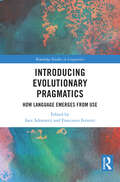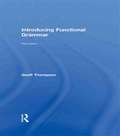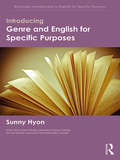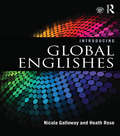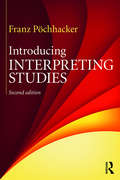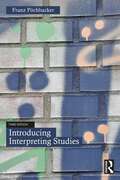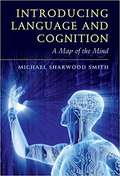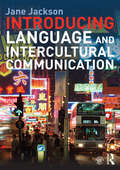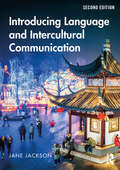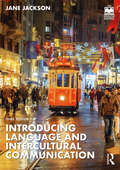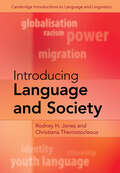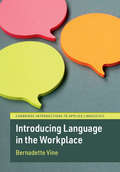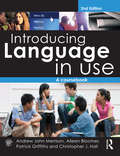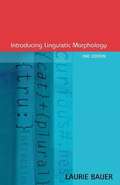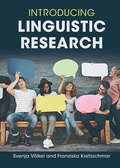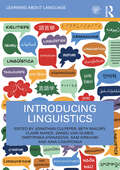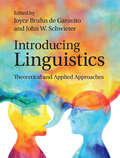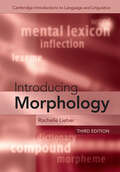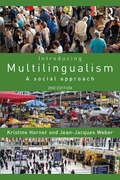- Table View
- List View
Introducing Evolutionary Pragmatics: How Language Emerges from Use (Routledge Studies in Linguistics)
by Ines Adornetti and Francesco FerrettiThis collection highlights a range of perspectives on the emerging body of research on evolutionary pragmatics, expanding the borders of language evolution research and indicating exciting new directions for the future of the field.The volume adopts a broad view of pragmatics, providing a counterpoint to classical models of language evolution by exploring the ways in which the origins of language can be traced through the emergence of language structures from use in context. The book synthesizes different lines of inquiry, ranging from evolutionary linguistics to cognitive linguistics, philosophy, and cognitive pragmatics, among other fields, which foreground the impact of the environment on language and of language, through speaker use, on context. The volume is organized around three sections, each taking in turn a different dimension of evolutionary pragmatics research; the origins of language as seen in animal communication; a closer look at the use of language in interaction for the formation of communication channel and linguistic meaning; the role of cooperation and competition dynamics for the emergence of language structure.This book will be of particular interest to scholars in evolutionary linguistics, language origins, cognitive pragmatics, cognitive archaeology, and cognitive semiotics, as well as related areas in philosophy, psychology, and anthropology.
Introducing Functional Grammar: Introducing Functional Grammar
by Geoff ThompsonIntroducing Functional Grammar, third edition, provides a user-friendly overview of the theoretical and practical aspects of the systemic functional grammar (SFG) model. No prior knowledge of formal linguistics is required as the book provides: An opening chapter on the purpose of linguistic analysis, which outlines the differences between the two major approaches to grammar - functional and formal. An overview of the SFG model - what it is and how it works. Advice and practice on identifying elements of language structure such as clauses and clause constituents. Numerous examples of text analysis using the categories introduced, and discussion about what the analysis shows. Exercises to test comprehension, along with answers for guidance. The third edition is updated throughout, and is based closely on the fourth edition of Halliday and Matthiessen's Introduction to Functional Grammar. A glossary of terms, more exercises and an additional chapter are available on the product page at: https://www.routledge.com/9781444152678. Introducing Functional Grammar remains the essential entry guide to Hallidayan functional grammar, for undergraduate and postgraduate students of language and linguistics.
Introducing Genre and English for Specific Purposes (Routledge Introductions to English for Specific Purposes)
by Sunny HyonGenre analysis has become a key approach within the field of English for Specific Purposes and helps students understand particular language use patterns in target contexts. Introducing Genre and English for Specific Purposes provides an overview of how genre has been conceptualized and applied in ESP, as well as the features that distinguish ESP genre research and teaching from those of other genre schools. The macro and micro aspects of ESP genre-based pedagogy are also analysed and include: different possibilities for planning and designing an ESP genre-based course; the concrete, micro aspects of materials creation; and how genres can be learned through play. Introducing Genre and English for Specific Purposes is essential reading for students and pre-service teachers who are studying Genre, English for Specific Purposes or language teaching methodologies.
Introducing Global Englishes
by Nicola Galloway Heath RoseIntroducing Global Englishes provides comprehensive coverage of relevant research in the fields of World Englishes, English as a Lingua Franca, and English as an International Language. The book introduces students to the current sociolinguistic uses of the English language, using a range of engaging and accessible examples from newspapers (Observer, Independent, Wall Street Journal), advertisements, and television shows. The book: Explains key concepts connected to the historical and contemporary spread of English. Explores the social, economic, educational, and political implications of English’s rise as a world language. Includes comprehensive classroom-based activities, case studies, research tasks, assessment prompts, and extensive online resources. Introducing Global Englishes is essential reading for students coming to this subject for the first time.
Introducing Historical Orthography
by Marco CondorelliHistorical orthography – the study of how writing systems have changed over time – is a rapidly growing area of historical linguistics. This book provides the first comprehensive introduction to this exciting focus of research. Written in an engaging and accessible way, it surveys the purposes and methods of this field, and how it has developed as a discipline over time. The volume also discusses the various levels of analysis that historical orthography can carry out, as well as key historical orthographic processes, such as standardization and language change. It covers a range of non-western and western languages, including English, in order to discuss the breadth of typological issues that can arise in the documentation of writing systems. The book also establishes links between orthography and a range of other related disciplines, a quality which makes it an essential resource for advanced students of orthography and writing systems, and historical linguistics.
Introducing Interpreting Studies
by Franz PöchhackerA millennial practice which emerged as a profession only in the twentieth century, interpreting has recently come into its own as a subject of academic study. This book introduces students, researchers and practitioners to the fast-developing discipline of Interpreting Studies. Written by a leading researcher in the field, Introducing Interpreting Studies covers interpreting in all its varied forms, from international conference to community-based settings, in both spoken and signed modalities. The book first guides the reader through the evolution of the field, reviewing influential concepts, models and methodological approaches. It then presents the main areas of research on interpreting, and identifies present and future trends in Interpreting Studies. Featuring chapter summaries, guides to the main points covered, and suggestions for further reading, Franz Pöchhacker’s practical and user-friendly textbook is the definitive map of this important and growing discipline. Introducing Interpreting Studies gives a comprehensive overview of the field and offers guidance to those undertaking research of their own. The book is complemented by The Interpreting Studies Reader (Routledge, 2002), a collection of seminal contributions to research in Interpreting Studies, and by the comprehensive Routledge Encyclopedia of Interpreting Studies (Routledge, 2015).
Introducing Interpreting Studies
by Franz PöchhackerThis bestselling textbook, now fully updated, introduces students, researchers and practitioners to the fast-developing discipline of Interpreting Studies. Written by one of the world’s leading researchers in Interpreting Studies, Introducing Interpreting Studies covers interpreting in all its varied forms, from international conference to community-based settings, in both spoken and signed modalities. The book first guides the reader through the evolution of the field, reviewing influential concepts, models and methodological approaches. It then presents the main areas of research on interpreting, and identifies present and future trends in Interpreting Studies. This edition has been updated to reflect recent advances in areas from cognitive neuroscience to multimodal discourse analysis and to cover technology-assisted and technology-mediated forms of interpreting, and the role of technology in interpreter training. Featuring chapter summaries, guides to the main points covered, and suggestions for further reading, Franz Pöchhacker’s practical and user-friendly textbook is the definitive map of this important and growing discipline. Introducing Interpreting Studies gives a comprehensive overview of the field and offers guidance to those undertaking research of their own. The book is complemented by The Interpreting Studies Reader (Routledge, 2002), a collection of seminal contributions to research in Interpreting Studies, and by the comprehensive Routledge Encyclopedia of Interpreting Studies (Routledge, 2015).
Introducing Language and Cognition
by Smith Michael SharwoodIn this accessible introduction, Mike Sharwood Smith provides a working model or 'map' of the mind, with language as its centrepiece. Drawing on cutting-edge research across linguistics, psychology and neuroscience, it allows students to quickly grasp how each separate aspect of the mind's operations can be related. This 'big picture' view includes the way the mind makes, stores and loses memories of all kinds as well how its various 'expert systems' combine and collaborate to solve, typically beyond our conscious awareness, the myriad of tasks we are faced with every minute and millisecond of our existence. The book also focuses on language, that is, the mind of monolingual, bilingual and multilingual speakers. It will be of interest to all students wishing to learn more about the complex relationship between language - one of the most important ways in which we define ourselves as human - and the mind.
Introducing Language and Intercultural Communication
by Jane JacksonIntroducing Language and Intercultural Communication is a lively and accessible introduction for undergraduates who are new to the area of intercultural communication. Incorporating real-life examples from around the world and drawing on current research, this text argues against cultural stereotyping and instead provides students with a skill-building framework to enhance understanding of the complexities of language and intercultural communication in diverse international settings. Readers will learn to understand and become aware of power relations, positioning and the impact of social and political forces on language choice and the intercultural communication process. This is the essential text for undergraduate students studying courses in intercultural communication for the first time. Features include: clear learning objectives to structure your study end of chapter discussion questions to test your knowledge highlighted glossary terms to provide a strong understanding of the relevant vocabulary an array of photos including signs which make use of non-verbal codes and many examples that illustrate such issues as intercultural misunderstandings and the effects of culture shock substantial online resources for students including learning objectives, suggested readings, links to media resources and real-world intercultural scenarios and activities. Additional in-depth instructor resources feature test materials, powerpoints, key terms, extended chapter outlines and sample assignments and syllabi.
Introducing Language and Intercultural Communication
by Jane JacksonIntroducing Language and Intercultural Communication is a lively and accessible introduction for undergraduates who are new to the study of intercultural communication, with a particular emphasis on the language dimension. Incorporating real-life examples from around the world and drawing on current research, this text argues against cultural stereotyping and instead provides students with a skill-building framework to enhance understanding of the complexities of language and intercultural communication in diverse international settings. Readers will learn to become more attuned to power relations and the ways in which sociopolitical forces can influence language choice/attitudes and the intercultural communication process. Features new to this edition include: Revised in-text discussion questions and the introduction of multiple exercises and examples that aim to engage students and provide a more interactive experience; New material that takes account of key social, cultural, and political events such as the refugee crisis, Brexit and the rise of populism in many parts of the world Updated theoretical constructs that reflect recent trends in this area of study such as criticality in intercultural communication An updated Companion Website featuring suggested readings, links to media resources and real-world intercultural scenarios for students, as well as additional in-depth instructor resources featuring test materials, PowerPoints, key terms, extended chapter outlines, and sample assignments and syllabi Refreshed references and glossary to enhance understanding of key terms and concepts. This is the essential text for undergraduate students who are new to the field of intercultural communication.
Introducing Language and Intercultural Communication
by Jane JacksonThis fully updated third edition of Introducing Language and Intercultural Communication provides an accessible, lively introduction for students who are new to the study of intercultural communication, with special attention devoted to the language dimension. Incorporating real-life examples from around the world and drawing on current research, this text argues against cultural stereotyping and instead provides students with a skill-building framework to enhance understanding of the complexities of language use and intercultural communication in diverse settings. Readers will learn to become more attuned to power relations and the ways in which a complex mix of internal and external factors can influence language choice/attitudes, the intercultural communication process, and intercultural relationship building. Features new to this edition include: ‘pause and reflect’ boxes and images throughout each chapter that encourage meaning making and connections between theories and practice dialogues and student accounts of intercultural experiences that link theories with real-life applications discussion questions, journal jumpstarts, and suggested activities at the end of each chapter to engage students and provide a more interactive experience new material that takes account of key social, cultural, and political events, such as the COVID-19 pandemic, the refugee crisis, the climate emergency, and the rise of populism updated theoretical constructs that reflect recent developments in this area of study, such as criticality and reflexivity in intercultural communication refreshed references and glossary to enhance understanding of key terms and concepts revised and updated Instructor and Student Resources, including recommended resources on intercultural pedagogy, sample course schedules and assignments, in-depth chapter-specific resources, and a test bank revised and updated student resources, including suggested readings and links to online resources, key terms for each chapter, e-flash cards, study quizzes, and a glossary This is the essential textbook for introductory courses in language and intercultural communication within applied linguistics and communication studies.
Introducing Language and Society (Cambridge Introductions to Language and Linguistics)
by Rodney H. Jones Christiana ThemistocleousThis accessible and entertaining textbook introduces students to both traditional and more contemporary approaches to sociolinguistics in a real-world context, addressing current social problems that students are likely to care about, such as racism, inequality, political conflict, belonging, and issues around gender and sexuality. Each chapter includes exercises, case studies and ideas for small-scale research projects, encouraging students to think critically about the different theories and approaches to language and society, and to interrogate their own beliefs about language and communication. The book gives students a grounding in the traditional concepts and techniques upon which sociolinguistics is built, while also introducing new developments from the last decade, such as translanguaging, multimodality, superdiversity, linguistic landscapes and language and digital media. Students will also have online access to more detailed examples, links to video and audio files, and more challenging exercises to strengthen their skills and confidence as sociolinguists.
Introducing Language in the Workplace (Cambridge Introductions to Applied Linguistics)
by Bernadette VineAssuming no prior linguistics background, this introductory textbook summarises key topics and issues from workplace discourse research in a clear and accessible manner. The topics covered include how people issue directives, use humour and social talk, and how they manage conflict and disagreement. The role of language in the enactment of identity is also explored, in particular leadership, gender, and cultural identity, along with the implications and applications of workplace research for training and communications skills development. Over 160 international examples are provided as illustration, which come from a wide range of workplace settings, countries and languages. The examples focus on authentic spoken discourse, to demonstrate how theory captures the patterns found in everyday interaction. Introducing Language in the Workplace provides an excellent up-to-date resource for linguistics courses as well as other courses that cover workplace discourse, such as business communication or management studies.
Introducing Language in Use: A Course Book
by Aileen Bloomer Christopher J. Hall Patrick Griffiths Andrew John MerrisonIntroducing Language in Use, second edition, provides a lively and accessible introduction to the study of language and linguistics. Drawing on a vast range of data and examples of language in its many forms, this book provides students with the tools they need to analyse real language in diverse contexts. The second edition of this best-selling textbook has been fully revised and updated with entirely new chapters on Phonology and Sociolinguistics, two separate chapters on syntax and grammar, completely rewritten chapters on Multilingualism, Psycholinguistics and World Englishes, and a greater focus on corpus linguistics. Introducing Language in Use: covers all the core areas and topics of language study, including semiotics, communication, grammar, phonetics, phonology, words, semantics, variety in language, history of English, world Englishes, multilingualism, psycholinguistics, sociolinguistics, language acquisition, conversation analysis, pragmatics and politeness adopts a 'how to' approach, encouraging students to apply their knowledge as they learn it draws on examples of language from around the world in forms ranging from conversation to advertising and text messaging, always giving precedence to real language in use includes activities throughout the text and an extensive glossary of terms The book is supported by a companion website offering a wealth of additional resources including commentaries on the activities in the book, suggested further reading and references, links to useful websites, more texts to analyse, additional web activities, 'fun with language' exercises, discussion questions and an additional 'Language in Education' chapter. This is an essential coursebook for all introductory courses in English language, communication and linguistics. Visit the companion website at www.routledge.com/cw/merrison
Introducing Language Typology
by Edith A. MoravcsikLanguage typology identifies similarities and differences among languages of the world. This textbook provides an introduction to the subject which assumes minimal prior knowledge of linguistics. It offers the broadest coverage of any introductory book, including sections on historical change, language acquisition, and language processing. Students will become familiar with the subject by working through numerous examples of crosslinguistic generalizations and diversity in syntax, morphology, and phonology, as well as vocabulary, writing systems, and signed languages. Chapter outlines and summaries, key words, a glossary, and copious literature references help the reader understand and internalize what they have read, while activities at the end of each chapter reinforce key points.
Introducing Linguistic Morphology
by Laurie BauerA newly expanded and updated edition of one of the best-selling introductions to linguistic morphology -- the study and description of word formations in languages -- that deals with inflection, derivation, and compounding, the system of word-forming elements and processes in a language. Basic concepts are introduced, with an abundance of examples from a range of familiar and exotic languages, followed by a discussion of, among other topics, the definition of word-form, productivity, inflection versus derivation, and the position of morphology to phonology -- the science of speech sounds, especially the history and theory of sound changes in a language. Along with two new chapters discussing morphology and the brain and how morphology arises, changes, and disappears, this new edition includes exercises and a glossary of key terms.
Introducing Linguistic Research
by Svenja Voelkel Franziska KretzschmarOver the past decade, conducting empirical research in linguistics has become increasingly popular. The first of its kind, this book provides an engaging and practical introduction to this exciting versatile field, providing a comprehensive overview of research aspects in general, and covering a broad range of subdiscipline-specific methodological approaches. Subfields covered include language documentation and descriptive linguistics, language typology, corpus linguistics, sociolinguistics and anthropological linguistics, cognitive linguistics and psycholinguistics, and neurolinguistics. The book reflects on the strengths and weaknesses of each single approach and on how they interact with one-another across the study of language in its many diverse facets. It also includes exercises, example student projects and recommendations for further reading, along with additional online teaching materials. Providing hands-on experience, and written in an engaging and accessible style, this unique and comprehensive guide will give students the inspiration they need to develop their own research projects in empirical linguistics.
Introducing Linguistics (Learning about Language)
by Jonathan Culpeper Beth Malory Claire Nance Daniel Van Olmen Dimitrinka Atanasova Sam Kirkham Aina CasaponsaIntroducing Linguistics brings together the work of scholars working at the cutting-edge of the field of linguistics, creating an accessible and wide-ranging introductory level textbook for newcomers to this area of study. The textbook: • Provides broad coverage of the field, comprising five key areas: language structures, mind and society, applications, methods, and issues; • Presents the latest research in an accessible way; • Incorporates examples from a wide variety of languages – from isiZulu to Washo – throughout; • Treats sign language in numerous chapters as yet another language, rather than a ‘special case’ confined to its own chapter; • Includes recommended readings and resource materials, and is supplemented by a companion website. This textbook goes beyond description and theory, giving weight to application and methodology. It is authored by a team of leading scholars from the world-renowned Lancaster University department, who have drawn on both their research and extensive classroom experience. Aimed at undergraduate students of linguistics, Introducing Linguistics is the ideal textbook to introduce students to the field of linguistics.
Introducing Linguistics: Theoretical and Applied Approaches
by de Garavito, Joyce Bruhn John W. SchwieterEverything we do involves language. Assuming no prior knowledge, this book offers students a contemporary introduction to the study of language. Each thought-provoking chapter is accessible to readers from a variety of fields, and is helpfully organized across six parts: sound; structure and meaning; language typologies and change; language and social aspects; language acquisition; and language, cognition, and the brain. The book's companion website also offers three brief chapters on language and computers; animal communication; and dialectal varieties of English. The chapters feature illustrative tables, figures and maps, along with three types of pedagogical boxes (Linguistic Tidbits; Pause and Reflect; and Eyes on World Languages) that break up text, contextualize information, and provide colourful accents that give real data from languages across the globe. Key words are bolded and defined in a glossary at the end of the book, while end-of-chapter summaries and practice exercises reinforce the key points discussed.
Introducing M.A.K. Halliday
by Bo Wang Yuanyi MaM.A.K. Halliday (1925–2018) was the founder of Systemic Functional Linguistics (SFL) and, undoubtedly, one of the most influential linguists of his time, credited with changing the way that language and linguistics have been taught. SFL, as an appliable theory that approaches language as social semiotic, is the study of the relationship between language and its functions in social settings. Moreover, SFL conceives of language as a resource for making meaning and organizes language systemically as a huge network of interrelated choices of meaning. This book is an introduction to the life and seminal works of Halliday. Targeting both SFL and non-SFL scholars, this book introduces Halliday’s life and work in simple terms, expounds his theoretical conceptions, illustrates how his theories have been applied to various areas of linguistics and offers additional readings for researchers who want to explore this area further. Divided into six sections covering Hallidayan connections, theory and architecture of language, Hallidayan conceptions of language, systems and the modes of meaning, and applications of SFL, this accessible introduction is a key resource for researchers and students within the fields of linguistics and applied linguistics.
Introducing Metaphor
by Murray Knowles Rosamund MoonAdopting a multi-disciplinary approach, the book provides a thorough grounding in metaphor and word meaning, theories on the processing and understanding of metaphorical language, and metaphor in other languages and translation. Rosamund Moon and Murray Knowles, draw on a wide selection of material to explore metaphor in relation to text, discourse and society. Linguistic metaphor and literary metaphor are examined across a range of contexts, such as politics, sport and advertising, whilst literary metaphor is demonstrated through authentic extracts from fiction and poetry. A final section covering non-verbal metaphor looks at metaphor in art, cinema and music.
Introducing Morphology (Cambridge Introductions to Language and Linguistics)
by Rochelle LieberA lively introduction to morphology, this textbook is intended for undergraduates with relatively little background in linguistics. It shows students how to find and analyze morphological data and presents them with basic concepts and terminology concerning the mental lexicon, inflection, derivation, morphological typology, productivity, and the interfaces between morphology and syntax on the one hand and phonology on the other. By the end of the text students are ready to understand morphological theory and how to support or refute theoretical proposals. Providing data from a wide variety of languages, the text includes hands-on activities designed to encourage students to gather and analyse their own data. The third edition has been thoroughly updated with new examples and exercises. Chapter 2 now includes an updated detailed introduction to using linguistic corpora, and there is a new final chapter covering several current theoretical frameworks.
Introducing Morphology
by Rochelle LieberMorphology is the study of how words are put together. A lively introduction to the subject, this textbook is intended for undergraduates with relatively little background in linguistics. Providing data from a wide variety of languages, it includes hands-on activities such as 'challenge boxes', designed to encourage students to gather their own data and analyse it, work with data on websites, perform simple experiments, and discuss topics with each other. There is also an extensive introduction to the terms and concepts necessary for analysing words. Topics such as the mental lexicon, derivation, compounding, inflection, morphological typology, productivity, and the interface of morphology with syntax and phonology expose students to the whole scope of the field. Unlike other textbooks it anticipates the question 'Is it a real word?' and tackles it head on by looking at the distinction between dictionaries and the mental lexicon.
Introducing Multilingualism: A Social Approach
by Kristine Horner Jean Jacques WeberIntroducing Multilingualism is a comprehensive and user-friendly introduction to the dynamic field of multilingualism. Adopting a compelling social and critical approach and covering important social and educational issues, the authors expertly guide readers through the established theories, leading them to question dominant discourses on subjects such as integration, heritage and language testing. This second edition has been fully revised and updated, featuring new chapters on multilingualism in new media, the workplace and the family. Other key topics include: language as a social construct language contact and variation language and identity the differences between individual and societal multilingualism translanguaging flexible multilingual education. With a wide range of engaging activities and quizzes and a comprehensive selection of case studies from around the world, this is essential reading for undergraduate students and postgraduate students new to studying multilingualism.
Introducing Multimodality
by Jeff Bezemer Carey Jewitt Kay O'HalloranThis accessible introduction to multimodality illuminates the potential of multimodal research for understanding the ways in which people communicate. Readers will become familiar with the key concepts and methods in various domains while learning how to engage critically with the notion of multimodality. The book challenges widely held assumptions about language and presents the practical steps involved in setting up a multimodal study, including: formulating research questions collecting research materials assessing and developing methods of transcription considering the ethical dimensions of multimodal research. A self-study guide is also included, designed as an optional stand-alone resource or as the basis for a short course. With a wide range of examples, clear practical support and a glossary of terms, Introducing Multimodality is an ideal reference for undergraduate and postgraduate students in multimodality, semiotics, applied linguistics and media and communication studies. Online materials, including colour images and more links to relevant resources, are available on the companion website at www.routledge.com/cw/jewitt and the Routledge Language and Communication Portal.
